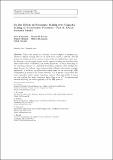On the Effects of Frequency Scaling Over Capacity Scaling in Underwater Networks—Part II: Dense Network Model
Author(s)
Shin, Won-Yong; Stojanovic, Milica; Tarokh, Vahid; Lucani, Daniel E.; Medard, Muriel
Download11277_2012_982_ReferencePDF.pdf (325.9Kb)
OPEN_ACCESS_POLICY
Open Access Policy
Creative Commons Attribution-Noncommercial-Share Alike
Terms of use
Metadata
Show full item recordAbstract
This is the second in a two-part series of papers on information-theoretic capacity scaling laws for an underwater acoustic network. Part II focuses on a dense network scenario, where nodes are deployed in a unit area. By deriving a cut-set upper bound on the capacity scaling, we first show that there exists either a bandwidth or power limitation, or both, according to the operating regimes (i.e., path-loss attenuation regimes), thus yielding the upper bound that follows three fundamentally different information transfer arguments. In addition, an achievability result based on the multi-hop (MH) transmission is presented for dense networks. MH is shown to guarantee the order optimality under certain operating regimes. More specifically, it turns out that scaling the carrier frequency faster than or as n[superscript 1/4] is instrumental towards achieving the order optimality of the MH protocol.
Date issued
2013-01Department
Massachusetts Institute of Technology. Department of Electrical Engineering and Computer Science; Massachusetts Institute of Technology. Research Laboratory of ElectronicsJournal
Wireless Personal Communications
Publisher
Springer US
Citation
Shin, Won-Yong et al. “On the Effects of Frequency Scaling Over Capacity Scaling in Underwater Networks—Part II: Dense Network Model.” Wireless Personal Communications 71.3 (2013): 1701–1719.
Version: Author's final manuscript
ISSN
0929-6212
1572-834X